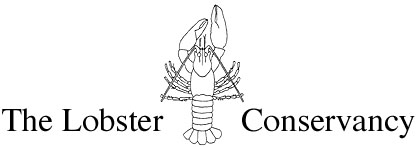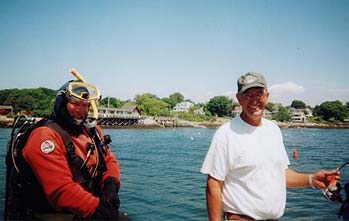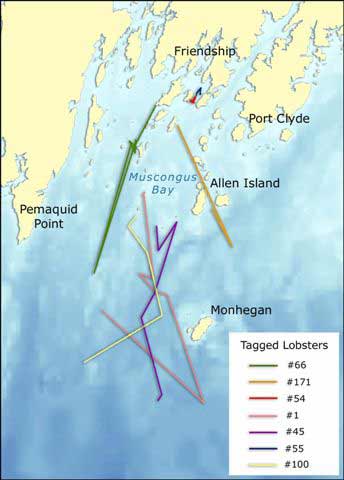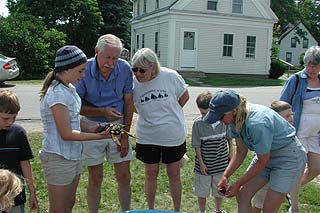
P.O. Box 235, Friendship, ME 04547 (207) 832-8224 www.lobsters.org

P.O. Box 235, Friendship, ME 04547 (207) 832-8224 www.lobsters.org
October, 2003
Dear Volunteers and Friends of The Lobster Conservancy,
The Lobster Conservancy's mission is to sustain a thriving lobster fishery through science and community. This newsletter keeps our friends and volunteer research team informed of our activities. Here's what we've been up to over the past few months.
News from the Board of Directors
Welcome to Andrew Mountcastle of Orono, Maine who joined the crew at TLC this month as our new Island Fellow. Andrew, a Bowdoin College graduate, will be involved in all our ongoing projects, including lobster sonar tracking, juvenile lobster monitoring, lobster behavior work at the Lobster Life Studies Center, facility improvement at Little Morse Island, and education. Andrew brings a wealth of marine research experience and an interest in sustainable living practices to TLC we hope to tap his knowledge of solar power applications for the building on LMI! Thanks to the Island Institute for their generous financial and technical support of this fellowship.
Welcome also to John Foote, who has joined TLC’s board as Treasurer. John is Vice President of TransCore in Southborough, MA and is very active with other non-profit organizations; he brings with him great savvy in fund raising and organizational management. John and his wife Kristen Rupert have a local connection through their family home on Martin Point in Friendship. Thank you to John and Kristen for organizing “Martin Point Day” out on Friendship Long Island this summer.
We are pleased to announce several recent grants. Thank you to the National Fish and Wildlife Foundation for a Challenge Grant to support Year II of our Lobster Sonar Tracking Project (see below). We are grateful to the Maine Lobster Advisory Council and the Bruce J. Anderson Foundation of the Boston Foundation for continuing to support the Juvenile Lobster Monitoring Program, and to Fisher Charitable Trust for providing general support for our research programs.
In August we held our first event to thank Lobster Quadrille level members for their high level of support. Thank you to all who could come out to Friendship Long Island to enjoy the beautiful evening. Thank you to artist Alice Ingraham for sponsoring the event, to lobstermen Richard Nelson and Bill Rourke for donating lobsters, and to Pat Taylor and Michele Walsh for catering the delicious feast.

Delicious fare complements the view from TLC’s wharf
at Friendship Long Island, the site of our most recent Quadrille event. (Photo
by Lynn Case)
Research News
Juvenile Lobster Project
The JLMP continues to grow in 2003 we added 4 new sites and 30 new volunteers! Now 92 volunteers monitor 28 sites from Great Wass Island in Downeast Maine to Nahant in Boston Harbor. On the lowest low tides of the month, you can find these dedicated citizen scientists tallying up the juvenile lobsters along the shoreline. Part of the program expansion was requested by the Lobster Advisory Council and the Maine Department of Marine Resources, so that we would have at least one monitoring site in all seven of Maine’s lobster management zones (previously we were in four). We will be analyzing the volunteers’ data this fall to look for trends. So far, it looks like 2003 is turning up the highest densities of newly settled and young-of-the-year lobsters on record.
This year, the lobster fishing season got off to a slow start, with landings down from the last few record-breaking years. The best explanation for this is that cold bottom water temperatures have resulted in less physical activity and delayed molting (shedding). Lobster movements, physiology and growth are all temperature dependent. Catchability of lobsters depends on the lobsters’ motivation to crawl into baited traps.
The Lobster Conservancy sees no indication that there are actually fewer lobsters on the bottom they are simply not growing as quickly or trapping as well as they were in warmer years. As mentioned above, our juvenile lobster censuses are showing both the highest densities of settlers and young-of-the-year lobsters we have ever recorded and the presence of newly settled postlarval and juvenile lobsters where we do not ordinarily see them. This bodes well for the future of the lobster fishery. Long-term comparative study We are continuing work on our comparison of subtidal and intertidal juvenile lobster habitats, which is supported generously by the UpEast Foundation. Hourly temperature data are recorded at -0.3 meter, 5 meter and 10 meter depths at TLC’s three sentinel juvenile lobster monitoring sites: Lowell’s Cove on Orr’s Island, Deep Cove on Friendship Long Island and North Beach on Allen Island. Lobster density and tagging studies are in progress at the -0.3 meter and 5-meter deep sites at all three locations. Thanks to the enthusiastic diving help of Friendship fisherman, Jim Bolen, and tending by his sternman, Paul Samuels, we located a study site near Friendship Long Island early in the season. Lobsterman Pem Johnson of Orr’s Island has donated his services as a dive tender from his boat the Katrina J. Pem helped us locate a sampling site in Lowell’s Cove in September. Stay tuned for a comparison of lobster densities and size distributions at intertidal versus subtidal sites. Many thanks to our dive volunteers Mike Dunn and Steve Karpiak and to Sarah Havener and Rachel Wagaman for tending divers from the boat.

Mike Dunn (left) and Pem Johnson, enthusiastic members of our
invaluable volunteer dive team. (Photo by Sara Ellis)
Lobster Life Studies Center
Sonar Tracking Project
The Lobster Conservancy and a group of lobstermen in Friendship, Maine are involved in a unique research project tracking the movements of egg-bearing female lobsters. This project is funded by the Northeast Consortium, Davis Conservation Foundation, Darden Environmental Trust, with mapping support by the Island Institute. Co-Principal Investigators on the project are Diane, Andy Solow (Woods Hole Oceanographic Institution), and Win Watson (University of New Hampshire). The purpose of the Lobster Sonar Tracking Project is to investigate where and at what temperatures female lobsters spawn (egg out), carry (brood), and hatch their eggs (release larvae) and to test the Inshore Brood Stock Hypothesis. Lobsters generally spawn during late summer; brood their eggs for 9 – 12 months; then hatch their eggs the following spring and summer. The Inshore Brood Stock Hypothesis makes predictions about where spawning, brooding and hatching will occur and relates reproductive behavior to animal size and environmental covariates such as temperature. Prevailing views in the literature are that female lobsters migrate to deeper, warmer water in winter to achieve a temperature advantage for incubating their eggs. Our results suggest that shallow/deep water migrations only explain part of the story and that female lobsters that move to deeper warmer water do not necessarily brood their eggs for a shorter period of time. In addition, the female lobsters that traveled further than others in the study did not experience the warmest water temperatures. The biggest gaps in knowledge lie in where the females hatch their eggs – a critical piece of information for understanding larval dispersal.
Approximately 200 recently spawned female lobsters were tagged with an acoustic transmitter and an identification tag in the fall 2002. Lobstermen tracked the lobsters by hydrophone detection and by recapture in traps. Temperature data loggers were attached to the lobster to record hourly water temperature throughout egg development. Temperature data were recovered when lobsters were recaptured in lobster traps in spring, summer, and fall 2003.
Preliminary results reveal that approximately 1/3 of the tagged females remained within 2 km of the original capture location (coldest winter temperatures), 1/3 remained within 30 km (warmest winter temperatures), and the other 1/3 traveled distances up to 160 km and experienced intermediate winter temperatures. The long-distance travelers were recaptured in Massachusetts.
Multiple recaptures of female lobsters reveal that they are traveling while hatching their brood.

Movement patterns of seven sonar tagged, egg-bearing females
between September 2002 – August 2003
The behavior of walking then hatching, then walking, then hatching results in the broadcast of lobster larvae over a broad geographical range – a great dispersal strategy that avoids putting all of the eggs in one basket. To further cover all dispersal possibilities, the inshore brood stock lobsters appear to be engaging in at least three separate strategies that can be summarized as follows:
Outreach and Education
Lobster Literacy Team Creates Listserve
The collaborative group formed at TLC’s Lobster Literacy Retreat (April 2003) now has a new way to communicate and share information. The Lobster Literacy Listserve is up and running as of September 12, 2003. The listserve will function as an ongoing conversation vehicle as we test-drive new lobster lessons in our classrooms, ask questions, suggest changes, and share resources. If you’d like to listen in or join the conversation, log on to http://lists.msad40.org/cgi-bin/mailman/listinfo/lobster-lit and subscribe.
Post-graduate Education
Diane serves on several student thesis committees at the University of New Hampshire. Congratulations to Susan Little who did a stellar job successfully defending her Master’s thesis at the University of New Hampshire this summer. Susan worked with the Offshore Lobstermen’s Association – going out on many fishing trips and designing a method for lobstermen to collect data on their own. Susan compared Size at Maturity, Egg Production, and Body Size of lobsters captured in three areas of the offshore fishery: north, middle and south. There was a clear pattern where females captured in the north were larger in body size and matured at a larger size than females in the Middle and Southern regions. Offshore lobstermen and managers are taking her results into consideration for rule making.
Visits, Visitors and Presentations
There was much coming and going between TLC scientists and groups of visitors this summer. The Lobster Life Studies Center was the destination for several educational trips. Two pulling boats full of Hurricane Island Outward Bound students arrived June 27 to help clean and shore up the boundaries of the pound. The students then enjoyed lobster life cycle instruction with Diane and Linda. In his first teaching appointment after leaving TLC, Dan O’Grady accompanied a group of students in the Maine Island Youth Sail Program onboard the sailing vessel Harvey Gamage. One of the first stops on their voyage was the Lobster Life Studies Center, where Dan and Diane taught students about lobster life and described TLC’s programs. Chebeague Lobster Camp director Carol White and Island Institute fellow Leah MacDonald brought a group of 10 children to FLI to learn about lobstering and the lobster life cycle. Diane and Michele took a group of visitors from Quebec Labrador Foundation’s Latin American and Caribbean Fellowship Program to FLI to learn about TLC’s community-based marine research and conservation efforts. The fellowship participants, who hailed from Costa Rica, Ecuador, Belize, Mexico and St. Lucia, shared stories of conservation efforts in their homelands, highlighting some fascinating similarities in our collective experience. This cultural exchange was organized by Jennifer Atkinson, a QLF staff member and a Friendship resident.
The Lobster House also received many visitors over the summer. On Friendship Day, July 28, we opened our doors to the public. TLC staff and volunteers were on-hand to give tours. Our teenaged lobster instructors, Stephanie Cowan and Paul Archambault, imparted their lobster knowledge to visitors around the touch tank. On July 30, three future scientists and their instructor from the Youth Links program in Rockland paid a visit to the Lobster House to learn about our work.

Stephanie Cowan (left) engages Bob Goodwill & friend in
a lobster gender lesson while Diane (far right) searches TLC’s Friendship
Day touch tank for other interesting critters. (Photo by Bob Cowan)
The lobster pound at Little Morse Island did not stand idle after Dan’s departure. Eight teachers and environmental educators, members of Muscongus Among Us, enjoyed a potluck picnic and an impromptu nature walk around Little Morse Island on August 25.
In spite of all the visitors, TLC staff did our share of traveling this summer and fall. In July, Diane gave a lobster talk at a kayak symposium in Castine, while Linda visited the Wells National Estuarine Reserve to give a presentation for 15 Junior Researchers and led them in a lobster dissection. In August, Michele represented TLC at the Kieve Science Camp for Girls. On September 24, Linda facilitated educational activities about the intertidal zone for 2nd and 3rd grade visitors to the Conservation Education Fair. This is the second year TLC has participated in the fair, which was organized by Knox-Lincoln Soil and Water Conservation and held at the Union Fairgrounds. This month Diane presented “Doing Science with the Lobstering Community” at the annual meeting of Friends of Casco Bay.
Linda also presented information about the Lobster Larvae in the Classroom project and our Lobster Literacy Curriculum to teachers at the Island Teacher Conference, sponsored by the Island Institute (October 3), and at the Maine Science Teachers Association fall conference (October 10).
Harpswell’s Lobster ‘Hot Spots’
TLC celebrated its Harpswell roots and reported to the Harpswell community what we have been learning about lobsters. We did this with two events on October 18 and 19 at the Community Hall in Cundy’s Harbor and the Merriconeag Grange in West Harpswell. Both events began with a community dinner, followed by a presentation by Diane Cowan, and a question and answer period. Thank you to the Cundys Harbor Ladies Auxiliary and the members of the Merriconeag Grange for the delicious food each night. Door-prize winners Roger Allard and Ruth Smith were thrilled with the gift baskets of lobster loot that Mercedes Villamil kindly assembled. Many thanks to Laura Ridgewell, whoopee pie-maker extraordinaire, and to the organizing committee - Sue Hawkes, State Representative Leila Percy, Amy Watson, Stacy Welner, and John Guarnaccia - for a job well done.
Press Coverage
If you thought the spring was busy…
Threats to lobster habitat and migration in Harpswell, Diane’s oldest intertidal study area, prompted Diane to write an editorial rejecting a proposal to build a liquefied natural gas pipeline and seawater desalinization plant there. A version of that editorial appeared as a guest column in the online edition of VillageSoup on October 7. Access this article at http://camden.villagesoup.com/Opinions/GuestCols.cfm?StoryID=2298.
TLC programs continued to capture media attention this summer and fall. Publications throughout New England, including The Gloucester Daily Times (MA), The Downeast Coastal Press (ME), Machias Valley News Observer (ME) and the Downeast Lobstermen’s Association Newsletter (ME), featured stories about the JLMP in June, July or August. Reporter Brendan Horton, an editor for Zoogoer magazine (the official publication of the National Zoo in Washington, D.C.), accompanied Sara and Michele for the monthly census and microwire tagging of juvenile lobsters on Friendship Long Island in late August. Brendan is writing a story about the lobster fishery in the Northeast and will likely return to interview Diane.
An in-depth explanation of TLC’s use of coded microwire tags for mark/recapture investigations of juvenile lobsters can be found in the July 2003 edition of the Maine IS Technology (MIST) Newsletter. The MIST publication highlights the creative use of technology in Maine, and solicited articles from Diane about both TLC’s microwire tagging work and use of Passive Integrated Transponder (PIT) tags in research lobsters (see TLC’s June 2003 newsletter for details.)
In August, as part of his column ‘On the Waterfront’, journalist Joe Appel cited TLC as an example of the profundity of local knowledge about lobsters. He interviewed Sara at length about all of TLC’s activities and our role in increasing the current body of knowledge about lobster biology and the Maine lobster fishery. A copy of this profile, published in the Portland newspaper, The Forecaster, will be accessible on our website later this month.
TLC’s lobster expertise also proved useful to USA Today reporter April Holladay, who sought Diane’s opinion on the likely lifespan of the Homarus americanus who manages to avoid the lobster trap. See Diane’s answer by visiting the website: http://www.usatoday.com/news/science/wonderquest/2003-09-11-wonderquest_x.htm
Diane’s knowledge of colormorphs - lobsters of unusual colors - proved useful to A.J. O’Connell, staff writer for The Hour, a newspaper in Norwalk, CT. A Connecticut lobsterman captured a rare blue lobster, which was nicknamed ‘Bluebell’, and donated her to a local aquarium. A paper about colormorphs, authored by Diane, was quoted in the August article.
TLC staff and supporters also enjoyed ‘mugging’ for Courier-Gazette photographers Joseph Cyr and Steve Rzasa, who captured some great moments at TLC’s Sea Creature Touch Tank on Friendship Day in July and of Lobster Larvae in the Classroom activities in June at the Friendship Village School’s 6th grade classroom.
On the academic front, TLC Vice President Kari Lavalli published the results of a comparative study of the defense mechanisms of different lobster species. Congratulations, Kari! The paper is available online at http://www.int-res.com/abstracts/meps/v256/p171-182.html.
Be sure to visit our press page from time to time to read the latest news coverage of TLC's programs.
Multitudes of Thanks
Since TLC’s inception we have been blessed with incredible support from our friends. We want to thank local and regional community members for their contributions of various kinds to our programs, including:
We are thankful to all the participants in our Sonar Tracking Project, including Diane’s co- principal investigators Winsor Watson, III (University of New Hampshire) and Andrew R. Solow (Woods Hole Oceanographic Institution). We couldn’t do the work with the active participation of local lobstermen Richard Barter, F/V Tammy Jean II; Denny Benner, F/V Maureen R; Kevin Benner, F/V Wanda Marie; Philip Bramhall, F/V Amanda Kate; Mark Havener, F/V Sarah Ashley; Steve Lash, F/V Streaker II; Jonathan Murphy, F/V Redeemed; Richard Nelson, F/V Pescadero; Mark Wallace, F/V Pamela B. Thank you also to Dan O’Grady, Liv Detrick, and Chris Brehme (The Island Institute) for assistance with GIS mapping. And, last but certainly not least, thank you to ALL of the lobstermen who have phoned in recapture information about our sonar tagged lobsters.
Announcements
Have a few hours a week to spare? Looking for a way to invest in your community, do work that you can feel good about, and have a few laughs while you’re at it? The Lobster Conservancy seeks an office volunteer to help us with a variety of administrative tasks, including data entry, proofreading, stuffing envelopes, and answering phones. Please contact Sara for more information.
Visit with TLC scientists at the Blaine House Conference for Natural Resource-based Industries, scheduled for November 17, 2003 at the Augusta Civic Center. For details, please call Jody Harris at 207-287-5424. Hope to see you there!
TLC's Wish List
If you can spare any of the following items, we would be happy to give them a new home, providing they are in good working order. The value of your donation would, of course, be tax deductible. Please call us at 207-832-8224 about a potential donation.
As always, your support will be most appreciated. Be well, do good work and
eat lobster!
Yours in TLC and Friendship,
Sara Ellis, Executive Director and Diane Cowan, Senior Scientist